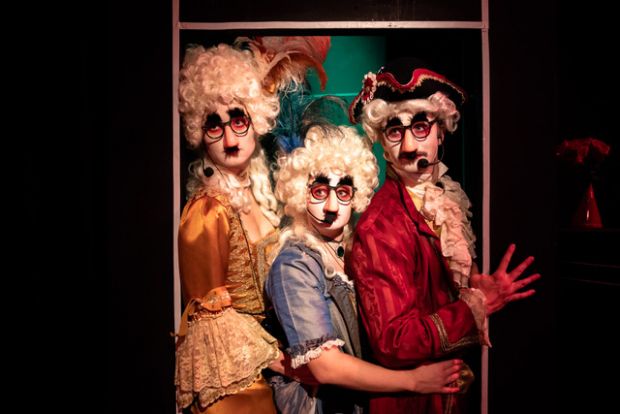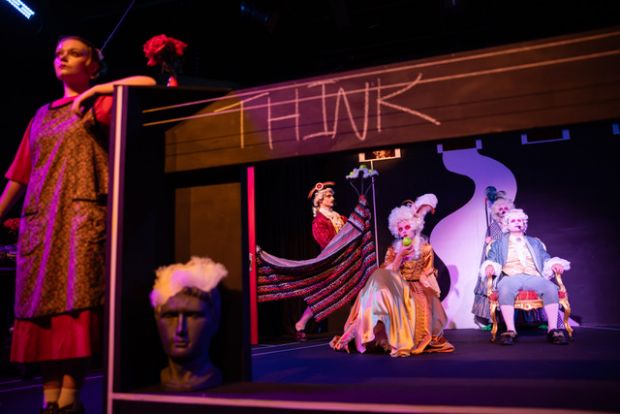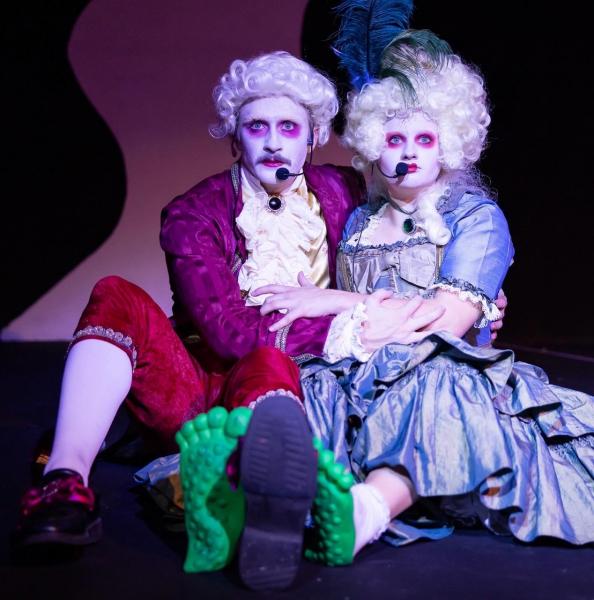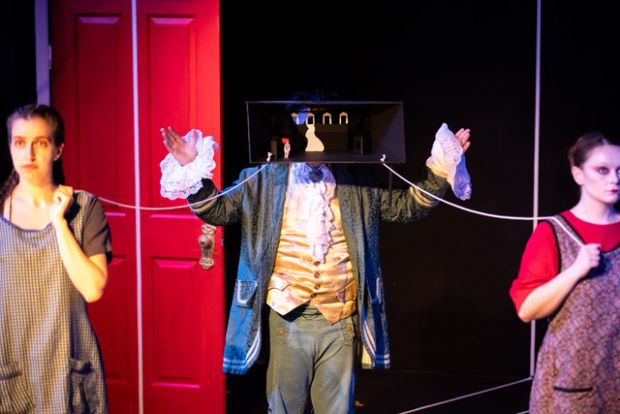By Richard Foreman. Phenomenological Theatre. Director Patrick Kennedy. New Theatre. 10-27 January, 2024
Reviewed : January 11, 2024

In program notes to Sydney’s premiere production of Richard Foreman’s 1972 avant-garde play Sophia=(Wisdom):The Cliffs, director Patrick Kennedy, renowned internationally for his stunning productions of Foreman’s plays suggests you:
“Sit back and allow your conscious mind to be enveloped in the cacophony of visuals, sounds and lights. Don’t expect catharsis and don’t expect a linear narrative.”

It’s good advice! Because this production is beyond different. Trying to find a narrative in the many short scenes would defeat the effect Kennedy is achieving. It is rather a “picturisation”: a sequence of tableaux with brief snatches of dialogue, augmented by some projected signs and definitions, unusual props and strange characters. In Foreman’s own words his play are a “theatrical experience rather than a narrative structure”.
That “theatrical experience” is orchestrated by Kennedy as director, stage manager, lighting and sound operator and stagehand. He will be at the back of the theatre for every performance, a deep measured voiceover, stopping the action with sharp blasts of sound, or interjections and black outs. He sets the pace, tempo and tone of the production – and his carefully schooled cast responds faithfully.

In a production that mixes dada, absurdism, alienation and slapstick in a series of interrupted scenes and orchestrated tableaux and strange props, one can really only do what Kennedy recommends and let “the images and sounds blur together to create a world.” React to what you see, rather than trying to work out what it means.
What is ‘seen’ is a cast of eleven actors. Some – Agustin Lamas, Lara Kocsis, Luke Visentin, Kirsty Saville and Beatrice McBride – are dressed in rich satin Restoration-style costumes complete with lace, feathers, coiffed wigs and heavy powered make up. These characters have small black microphones attached to distortion boxes that change and project their words.
Others – Katie Regan, Charmaine Huynh-Encluescu, Celeste Loyzaga. Nehir Hatipoglu and Heather Tiege – who wear simple dresses, aprons and different types of shoes are ‘factory workers’. Their makeup is plain, but their lips deep red. They carry props, change aspects of the set, hold ropes, write words on a black board. Izzy Azzopardi is also a mountain climber, complete with helmet and climbing boots.
The audience enters to a darkened auditorium. Sounds from the planet Jupiter fill the air. The set is dark. There is a red door on one side, a lighted widow on the other, a throne-like chair in the centre. Lines of tape run at angles from a cut out of waves at the front of the stage. A pair of long, striped clown pants hang high on one side. The sound effects get louder and louder – and stop. The red door opens and a man walks out and sits on the chair.
This is Max, husband of Rhoda, who, to enliven their marriage has summoned copies of themselves with the help of Sophia, Goddess of Wisdom. The mayhem that results forces Rhoda to flee, but the abominable snow man and the factory workers prevent her escape. But one would only know this if one had read a summary of the play!

All the action is stylised, faces devoid of expression. Movement is carefully choreographed, usually slow and studied, often resulting in a tableau with the characters facing the audience, their expressions blank, their eyes vacant – until Kennedy stops the scene with a blast of sound, a black out and loud music that heralds the next scene.
Props – a chair, a stool, a children’s swimming pool filled with frothy fake foam, an ironing board! – are carried or placed or removed by the ‘factory workers’, their movements meticulously timed and carried out with rigid precision, blank faces and wide eyes. Even when their faces appear in little cut out houses high in a backdrop, moving like metronomes with a finger each side of their heads, their faces are blank, their lips pursed, their eyes fixed.
There are many scenes, many changes of props and furniture, many actions and reactions as tableaux are formed and changed, but not one of this dedicated cast ever misses a programmed beat, even as they lift voluminous skirts to climb through a window manipulating a spear or a sword. Or are stopped several times in the middle of a creeping entrance, by Kennedy’s harsh “NOT NOW”.

Plays such as this present challenges that some actors love – they are different, non-linear, their characters are two dimensional, Brechtian. In this case Kennedy has stripped the script of stage directions and scenic pointers and adapted the script to his “own theatrical interests”. Obviously he has chosen a cast who thrives on this different, radical direction.
The result is a production from which you walk away talking not the story but about the direction, the colour, the costumes, the symmetry, the weird continuity, the strangeness of Rhoda’s green plastic feet …
And you are sure to remember Patrick Kennedy’s first production in Australia, and his
inspired take on this strange, absurd, “theatrical experience” written by Richard Foreman and first performed in 1972 – over 50 years ago.
Also published in Stage Whispers magazine